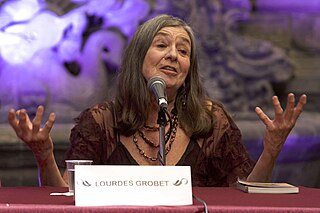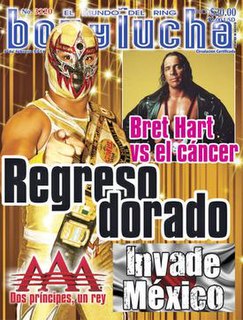
Lucha libre is the term used in Mexico for professional wrestling. Since its introduction to Mexico in the early 20th century, it has developed into a unique form of the genre, characterized by colorful masks, rapid sequences of holds and maneuvers, as well as "high-flying" maneuvers, some of which have been adopted in the United States and elsewhere. The wearing of masks has developed special significance, and matches are sometimes contested in which the loser must permanently remove his mask, which is a wager with a high degree of weight attached. Tag team wrestling is especially prevalent in lucha libre, particularly matches with three-member teams, called trios.

Salvador Lutteroth was a Mexican professional wrestling promoter of the mid-twentieth century. Lutteroth's promotion, Empresa Mexicana de Lucha Libre (EMLL), has been the dominant Mexican promotion since its founding in 1933, until Lutteroth left the company in the 1950s. Under its current name of Consejo Mundial de Lucha Libre (CMLL), it is, to date, the longest running active professional wrestling promotion in the world presenting three weekly matches. Lutteroth was known as the "father of lucha libre," and, in his position as promoter and booker of the dominant promotion, was the most powerful man in Mexican wrestling, and one of the most powerful wrestling executives in the world. He was, in large part, responsible for the widespread fame of the most famous Mexican professional wrestlers of the mid-twentieth century, such as Octavio Gaona, the first Mexican wrestler to win the middle weight championship of the world defeating Gus Kalio, Carlos Tarzan Lopez, El Santo, Gori Guerrero, Rene Guajardo, Karlof Lagarde, Enrique Yañez and the international league wrestler Medico Asesino, Rito Romero, Dorrel Dickson and Mil Mascaras, who wrestled in the United States, Japan and Europe.

Rayo de Jalisco Jr. is the ring name of a Mexican Luchador Enmascarado whose real name has not been revealed, per Lucha Libre traditions. Rayo de Jalisco Jr. is the son of Rayo de Jalisco a famous wrestler from the early days of Lucha Libre; he also has a son who wrestles under the name Rayman. Rayo Jr. is a former two time CMLL World Heavyweight Champion and the reigning WWA World Heavyweight Champion, a title he has held since March 21, 2003. Rayo de Jalisco Jr.'s real name is not a matter of public record, as is often the case with masked wrestlers in Mexico where their private lives are kept a secret from the wrestling fans.

Lourdes Grobet Argüelles is a contemporary Mexican photographer, known for her photographs of Mexican lucha libre wrestlers.

The World of Lucha Libre: Secrets, Revelations, and Mexican National Identity is a book, published in 2008, by Heather Levi. The book is an account of lucha libre, a term used in Mexico for a form of professional wrestling.
¡Que viva la lucha! is a 2007 film directed and produced by Gustavo Vazquez about Lucha libre in Tijuana, Mexico, considered to be a form of extreme lucha libre. The film follows Extreme Tiger, an up-and-coming professional luchador from Tijuana, on a journey that places him in a mask vs. hair match against Joe Líder. In addition, he follows other new talent, Angel Negro Jr. and Pancho Cachondo. In the process, the film also interviews other luchadores, promoters, commissioners, families, and fans who discuss the cultural significance of lucha libre as sport, ritual, and spectacle. The film includes music by Carne Cruda, Marziano, White Pine, and Nortec Collective. ¡Que viva la lucha! premiered at the 30th annual Mill Valley Film Festival on Saturday, Oct. 13, 2007, and has won two awards; at the Latino Film Festival and at the San Francisco International Film Festival.

In lucha libre, an exótico is a luchador fighting/performing in drag. The exótico’s movement vocabulary is campy, often silly, and seldom dignified. Exóticos are male wrestlers who appropriate feminine aspects in their wrestling personas or "gimmicks" – through feminine costumes, for example, ‘contesting the dramatic representation of machismo’ and successfully unmanning their opponents in the ring while also ‘rejecting the outward signs of manhood’. Though exoticos may not necessarily be gay, they often are, and their sexual ambiguity is undeniable. Attired with feather boas, headdresses, sequins or stockings, they defy a religious Latin culture that is ardently macho.

Blanca Rodríguez is a Mexican retired luchadora, or female professional wrestler, better known as Princesa Blanca. She is best known for working for the Mexican professional wrestling promotion Consejo Mundial de Lucha Libre (CMLL) portraying a ruda wrestling character. She held the Mexican National Women's Championship, for 1,793 days, the longest individual reign so far. Blanca is married to wrestler El Felino, making her part of the expanded Casas wrestling family; she is the step-mother of luchadors Tiger and Puma who all work for CMLL as well.
Gloria Alvarado Nava is a Mexican luchadora best known by the ring name Goya Kong for her time working for Lucha Libre AAA Worldwide (AAA) and Consejo Mundial de Lucha Libre (CMLL). She is the third generation Luchadora, part of the Alvarado wrestling family as she is the granddaughter of Shadito Cruz and the daughter of José Alvarado Nieves, who works under the ring name Brazo de Plata. She has several brothers and a sister who are also active wrestlers along with a number of uncles and cousins.

Ruleta de la Muerte (2012) was an annual professional wrestling major event produced and scripted by the Mexican professional wrestling promotion International Wrestling Revolution Group (IWRG), which took place on September 6, 2012 in Arena Naucalpan, Naucalpan, State of Mexico, Mexico. The focal point of the event was the eponymous Ruleta de la Muerte eight-man tournament where all participants put their wrestling mask or hair on the line. The Ruleta de la Muerte tournament is a Lucha libre stable, a tournament which unlike traditional tournaments it is the loser that advances in the tournament, advancing to the final that is contested under Luchas de Apuestas or bet rules.

Ruleta de la Muerte was an annual professional wrestling major event produced and scripted by the Mexican professional wrestling promotion International Wrestling Revolution Group (IWRG), which took place on May 5, 2015 in Arena Naucalpan, Naucalpan, State of Mexico, Mexico. The event was named after the Maine vent match, the Ruleta de la Muerte, a steel cage match where all four of the competitors were chained together. The last man in the cage would be forced to have his hair shaved off as a result. The four competitors risking their hair in the match were Ricky Cruz, Eterno, Veneno and X-Fly. The show featured four additional matches.

Promo Azteca was a professional wrestling promotion that was founded in Tijuana, Mexico by Fuerza Guerrera in 1995. It was taken over by Konnan and Jorge Rojas the following year and was home to many of the luchadors wrestling for World Championship Wrestling (WCW) during the late-1990s.
In Lucha libre, the Mexican version of professional wrestling, the Ruleta de la Muerte is a type of professional wrestling tournament where the loser or losers of a match would advance in the tournament instead of the winners. The finals of a Ruleta de la Muerte tournament featured the losing teams wrestle each other under Lucha de Apuestas, or "bet match" rules, where the loser would be forced to either unmask or have all their hair shaved off as a result. Various Mexican promotions have held Ruleta de la Muerte tournaments; some like International Wrestling Revolution Group have held these tournaments on a regular basis.
The Mexican professional wrestling promotion International Wrestling Revolution Group produced and scripted a Ruleta de la Muerte tournament on November 5, 2009. The show took place in Arena Naucalpan, in Naucalpan, State of Mexico, Mexico, IWRG's main venue and the site of the majority of all their major shows and tournaments.
The Mexican professional wrestling promotion International Wrestling Revolution Group produced and scripted a Ruleta de la Muerte tournament on October 27, 2013. The show took place in Arena Naucalpan, in Naucalpan, State of Mexico, Mexico, IWRG's main venue and the site of the majority of all their major shows and tournaments.

Súper Luchas is a Spanish-language publication covering lucha libre and other forms of professional wrestling. The publication began as a print magazine in 1991 and later became the largest lucha libre magazine in the world and remained one of the few professional wrestling magazines to survive to the 2000s but now operates mainly as an online website. The website is the number one Spanish-language professional wrestling website in the world.

Box y Lucha is a Spanish language magazine and website. It is the oldest lucha libre magazine still in existence and one of the first ones to be published. It also covers boxing and other martial arts.
Lady Shani is the ring name of a Mexican luchadora enmascarada, or masked professional wrestler, currently under contract with Lucha Libre AAA Worldwide. She made her debut in 2009 and until 2015 worked under the more generic name Sexy Lady before adopting her current name that same year. Initially she portrayed a ruda but in 2017 she changed sides and became a tecnica. She is the cousin of Ludark Shaitan, with whom she both teamed with and fought against early in her career. Lady Shani's real name is not a matter of public record, which is traditional for masked wrestlers in Mexico who have not been unmasked.











